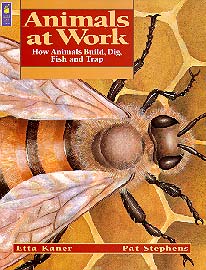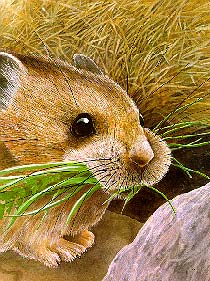| ________________
CM . . .
. Volume VIII Number 7 . . . . November 30, 2001
exerpt:
Teacher Etta Kaner's short (40, heavily illustrated pages) book, Animals at Work, takes a look at adaptations some animals employ to build shelter, secure food and attract a mate. The animal examples include creatures with intriguing habits like the Gray tree frog that beats sticky liquid with its legs to create a foamy nest, and the green-backed heron that tosses bait onto the water while fishing. With the focus on the particular skill of each animal, this book is a useful introduction for young researchers. The species examples are found world-wide, although the geographic location isn't provided, a small extra detail which would help students choose the most relevant information for their assignments.
The subtitle, How Animals Build, Dig, Fish and Trap does not reveal the entire contents. The book is arranged in chapters covering home building, attracting mates, nest building, catching food, getting into the food, and storing food. The index is exclusively a list of species used throughout the book; it does not show where to find details of "nests," for example, or the location of the activities that allow readers to experiment with some scientific principles involved in the animals' adaptations. The writing style is clear and straightforward, with age-appropriate vocabulary. Bold type for the names of various species would have made them easier to spot. Ditto for the term "replete" (page 39) used to describe a type of honeypot ant; this would likely be a new word for many readers. I believe a key word has been omitted on page 6: the second paragraph states "...not all honeybees are builders. Only the females work. They are called worker honeybees." But the insert reads: "If you were a [missing word: worker] honeybee...you would be a female." Illustrator Pat Stephens has undertaken several other projects in this series of animal information books. Her full-colour drawings are clear and functional for the most part. There are a couple of exceptions: a double-page spread of identical male and female mallee fowl is rather ineffective. The static pose of the birds on an indistinct background does not extend the interesting details in the text. Also, on page 8, the sequential drawings do not quite match the description of the activity of the soldier crab. Recommended. Gillian Richardson is a former teacher-librarian and a published children's writer of fiction and nonfiction, living in BC.
To comment on this
title or this review, send mail to cm@umanitoba.ca.
Copyright © the Manitoba Library Association. Reproduction for personal
use is permitted only if this copyright notice is maintained. Any other
reproduction is prohibited without permission.
Published by
NEXT REVIEW |TABLE OF CONTENTS FOR THIS ISSUE - November 30, 2001.
AUTHORS
| TITLES | MEDIA REVIEWS
| PROFILES
| BACK ISSUES
| SEARCH | CMARCHIVE
| HOME
|

